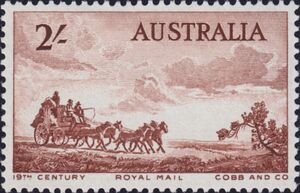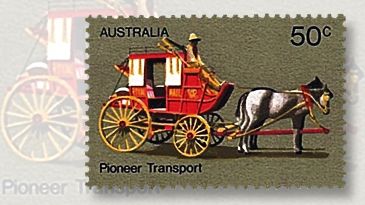Stamp Matters - October 2024 - Cobb and Co.
In Australia’s written history, there are a number of iconic people and organisations which add to the romance of the past and still engender interest today. One such is Cobb and Co, a transportation company which was founded in the gold-rush days. Its’ founders were four American goldminers who imported wagons and coaches from America. By 1854 the first routes from Melbourne to Forest Creek and Bendigo were established and soon after, to Geelong, Ballarat and other gold-mining settlements.
Horses were changed after 10-15 miles depending on the conditions of the road and changing stations usually were found at way-side inns. The pattern can still be seen on maps.

After establishing a speedy, reliable and affordable business, Cobb and his partners sold the business in 1856. It passed quickly through a number of hands until it was bought by another consortium, headed by American James Rutherford. He extended the routes to cover most of Victoria and won a monopoly for carrying the mail, did not go into competition with the expanding rail network, but arranged the timetables to fit in with the railways. The largest coach built for the company was the ‘Leviathan’, which plied the Geelong-Ballarat route from 1860. It carried up to 60 passengers, featured a lady’s compartment inside along with four bench seats, and seven benches on the roof. It was pulled by a team of eight horses.

In the meantime, the transport of passengers and freight in other states was being serviced by other companies who used the name of Cobb and Co, the name which had become synonymous with speed and efficiency. The companies existed in harmony with each other as the original company expanded into other states. Rutherford established the original company’s coach routes into N.S.W. in 1862 with its headquarters in Bathurst where a coach-building factory was established. It extended into Queensland in 1865 and Charleville was the site of coachworks in that state.
Rutherford bought out most of his competitors as he expanded throughout the Eastern states. Beyond these Eastern states, South Australia was serviced by another company, Cobb and Co Limited, as was New Zealand and for a short time, Japan and South Africa. Cobb and Co carried on through the 19th century but the end was nearing for the company. The extending railways and the developing motor truck were too much competition for the horse-drawn vehicles and the last services ran in Victoria in 1913, N.S.W. in 1916 and Cobb and Co Queensland went into liquidation in 1929. However, the romance endured. Many coaches were restored up and down the country and exist in museums, featuring from time to time in local parades. A Cobb and Co museum is found in Queensland. Cobb and Co features in the poetry and stories of our early writers and in the N.S.W. State Art Gallery you can view the painting ‘Bailed Up’ by Tom Roberts. Stamps featuring Cobb and Co coaches were issued in 1955 and 1972.


